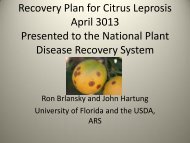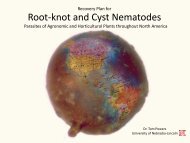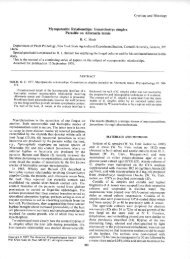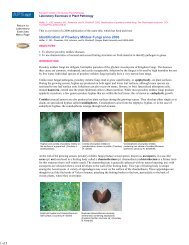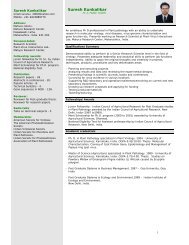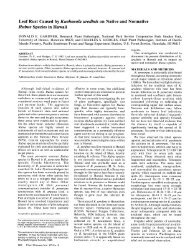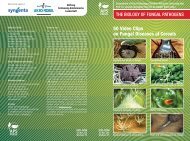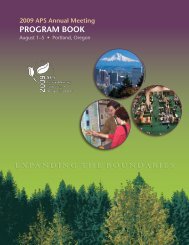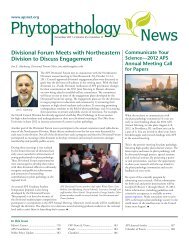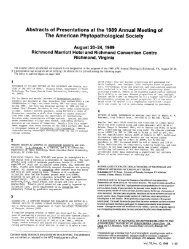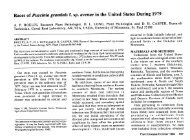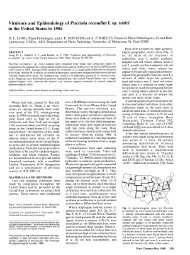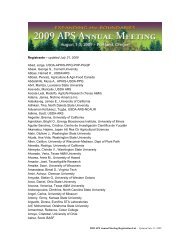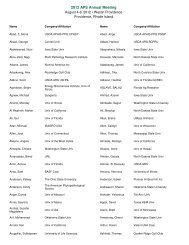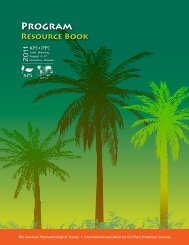See the program book (PDF) - American Phytopathological Society
See the program book (PDF) - American Phytopathological Society
See the program book (PDF) - American Phytopathological Society
Create successful ePaper yourself
Turn your PDF publications into a flip-book with our unique Google optimized e-Paper software.
y inoculation to optimize production efficiency and/or<br />
enhance food quality? And, how does reliance on natural<br />
and augmentative biocontrols vary by crop, regions, and<br />
internationally?<br />
1:00 p.m. Open-Forum Discussion. B. MCSPADDEN<br />
GARDENER (1). (1) The Ohio State University-<br />
OARDC, Wooster, OH, U.S.A.<br />
Citrus Canker: A Case Study in Regulatory Plant<br />
Pathology; Past, Present, and Future<br />
1:00 – 2:30 p.m. * 205 CD<br />
Section: Plant Disease Management<br />
Organizer/Moderator: Timothy D. Riley, USDA-APHIS-<br />
PPQ, Orlando, FL<br />
Sponsoring Committees: Regulatory Plant Pathology<br />
The symposium will focus on <strong>the</strong> complete cycle of plant<br />
health regulations for a quarantined plant pathogen using<br />
citrus canker as an example. The events which occurred during<br />
<strong>the</strong> eradication <strong>program</strong> in Florida will be addressed, including<br />
science and risk assessment issues, legislative process, industry<br />
involvement, and disease management. The symposium<br />
will also consider <strong>the</strong> changing trend in establishing future<br />
<strong>program</strong>s which incorporate a larger industry involvement in<br />
addressing pest management practices.<br />
1:00 p.m. S-78. The changing face of regulatory plant<br />
pathology. N. K. OSTERBAUER (1). (1) Oregon<br />
Dept of Agric, Salem, OR, U.S.A.<br />
1:15 p.m. S-79. Historical overview of <strong>the</strong> citrus canker<br />
eradication <strong>program</strong>. T. S. SCHUBERT (1). (1)<br />
Florida Dept of Agric & Con Serv., Gainesville,<br />
FL, U.S.A.<br />
1:30 p.m. S-80. Science-based regulatory decisions. T. R.<br />
GOTTWALD (1). (1) USDA ARS USHRL, Ft.<br />
Pierce, FL, U.S.A.<br />
1:45 p.m. S-81. Best management practices post eradication.<br />
J. GRAHAM (1). (1) UF IFAS CREC, Lake<br />
Alfred, FL, U.S.A.<br />
2:00 p.m. S-82. Impact of <strong>the</strong> citrus canker eradication<br />
<strong>program</strong>’s regulatory decisions on <strong>the</strong> Florida<br />
citrus industry. D. RICHEY (1). (1) Riverfront<br />
Packing Co. LLC, Vero Beach, FL, U.S.A.<br />
2:15 p.m. S-83. Future challenges in regulatory plant<br />
pathology and health management <strong>program</strong>s. P.<br />
J. GOMES (1). (1) USDA APHIS PPQ-EDP,<br />
Raleigh, NC, U.S.A.<br />
New Products and Services<br />
1:00 – 2:30 p.m. * 208 AB<br />
Section: Plant Disease Management<br />
Organizer/Moderator: Aaron Hert, Syngenta Crop<br />
Protection, Vero Beach, FL<br />
Sponsoring Committees: Industry<br />
This session provides a forum for highlighting new products<br />
and services that are in <strong>the</strong> pipeline or are now offered to<br />
growers and researchers to aid in managing or understanding<br />
plant diseases.<br />
1:00 p.m. Welcome<br />
1:00 p.m. S-84. Syngenta: Inspire Super for gummy stem<br />
blight control. A. HERT (1). (1) Syngenta Crop<br />
Protection, Vero Beach, FL, U.S.A.<br />
1:10 p.m. S-85. BASF: Update on seed treatments. H.<br />
YPEMA (1). (1) BASF Corporation, Research<br />
Triangle Park, NC, U.S.A.<br />
1:20 p.m. S-86. BASF Fungicides Update: Registrations and<br />
label changes. T. BARDINELLI (1). (1) BASF<br />
Corporation, Durham, NC, U.S.A.<br />
1:30 p.m. S-87. EnviroLogix: QualiPlate, Innovation<br />
in ELISA Detection of Lettuce Mosaic Virus,<br />
plus QualiStix, 1 st LFD Detection of this new<br />
pathogen, Tomato Apex Necrosis Virus. K.<br />
MCGUIRE (1). (1) EnviroLogix Inc., Portland,<br />
ME, U.S.A.<br />
1:45 p.m. S-88. Presidio: A new Oomycete fungicide, with<br />
a unique mode of action, for use in vegetables,<br />
grapes and turfgrass. J. A. PAWLAK (1). (1)<br />
Valent U.S.A. Corp., Lansing, MI, U.S.A.<br />
1:55 p.m. S-89. Dupont Fungicides Update: Punch 3.3<br />
EC and DPX-LEM17. M. J. MARTIN (1). (1)<br />
DuPont Crop Protection, Columbus, OH, U.S.A.<br />
2:10 p.m. S-90. Spectrum Technologies: New spectrum<br />
light meters. C. TURSKI (1). (1) Spectrum<br />
Technologies, Plainfield, IL, U.S.A.<br />
2:20 p.m. S-91. Update: Revisions to <strong>the</strong> Pesticide Periodic<br />
table. B. OLSON (1). (1) Dow Agrosciences,<br />
Indianapolis, IN, U.S.A.<br />
Teaching Plant Pathology: Ideas and Tools for Today’s<br />
Classrooms<br />
1:00 – 2:30 p.m.* 200 FG<br />
Section: Professionalism/Service/Outreach<br />
Organizers/Moderators: Courtney Gallup, North Carolina<br />
State University, Raleigh, NC; Ka<strong>the</strong>rine Whitten Buxton,<br />
North Carolina State University, Raleigh, NC<br />
Sponsoring Committees: Graduate Student, and Teaching<br />
Universities are investigating novel teaching and learning<br />
models and new technologies to successfully influence<br />
students in today’s changing culture. This symposium will<br />
explore effective teaching tools that heighten student academic<br />
engagement and attract a broader audience into <strong>the</strong> discipline.<br />
Active and problem-based learning techniques maintain<br />
interest and relevance throughout a course. Fur<strong>the</strong>rmore, wellplaced<br />
technologies and web resources enhance understanding<br />
in a traditional classroom, reach nontraditional students,<br />
and provide a means to encompass more material within a<br />
departmental curriculum. In order to assess <strong>the</strong>ir effectiveness,<br />
teachers must be able to critically evaluate strategies to<br />
determine <strong>the</strong> effects on student learning and outcome. This<br />
symposium offers insight to <strong>the</strong>se topics and explores ideas and<br />
tools that may enhance a plant pathology classroom.<br />
1:00 p.m. S-92. Looking in, reaching out: Mainstream<br />
microbes. G. W. HUDLER (1). (1) Cornell<br />
University, Plant Pathology, Ithaca, NY, U.S.A.<br />
1:30 p.m. S-93. Utilizing technology to enhance teaching<br />
effectiveness and shape new curricula. H. D.<br />
55<br />
tueSDAy



